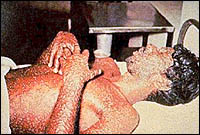
The Threat
“The most dangerous epidemic is the smallpox...
which sweeps at times like a storm of death over the land.”
Richard Burton, 1860

Smallpox was introduced into the Americas in the 16th century and into Australia in the 18th century. It had been present in Africa, Asia and Europe since at least 400 BCE.
Throughout the last three thousand years, smallpox has shadowed civilization. A viral infection, the disease spread along trade routes, emerging first in Africa, Asia and Europe and reaching the Americas in the sixteenth century. Because smallpox requires a human host to survive it tended to smolder in densely populated areas, erupting in a full-blown epidemic every ten years or so.
Wherever it appeared, the legacy of smallpox was death, blindness, sterility and scarring.

This quarantine poster dates from the early 20th century and was used in San Francisco.
While some medical practitioners claimed to cure smallpox, most medical traditions focused on prevention. Quarantining smallpox patients often limited the spread of the disease and was commonly used even into the twentieth century as there is no cure for smallpox.

This was smallpox.
WHO photograph

Smallpox, or the variola virus, is highly infectious and can be transmitted through contact with an infected individual or objects belonging to an infected individual. The disease produces an intense burning fever followed by the eruption of multiple pustules on the body’s surface. Death occurs in about 30% of all smallpox cases.
Last Reviewed: March 5, 2024

